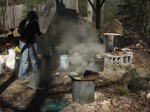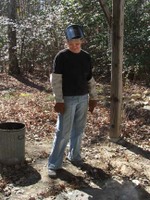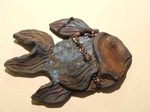 Hand-built clay fish, Pearl, raku fired by Tammy Vitale of Tam’s Originals
Hand-built clay fish, Pearl, raku fired by Tammy Vitale of Tam’s Originals
(This is yesterday’s post. For whatever reason, after cable went out yet again – thank you Comcast – the photo buttons weren’t working and this was to be a photo blog, so I gave up. I copied what I had already typed so I didn’t lose it and I will just pick up the strand today)
I decided to write a little bit and post a bunch of pictures from my last raku firing since my head is focused on yard work (5 hours of raking and mulching Monday and now another 3 yesterday) and I haven’t been in the studio (except for the 2 kiln loads I did last week, which are posted here under "new work" on the left column).
Raku, I read in one post, means "happy accident." Discovered thousands of years ago, traditionally raku was about an afternoon of making tea cups which were made and fired and used the same day. Because the process is a very fast one, much ware is lost in the process. The Western world, not much for "the process" has developed ways to make it work better. Still, there are parameters that the clay and fire require and the claymaker must honor, or the kiln imps will have their way and the claymaker be left with shards and work for another day.
I am somewhat of a novice with raku. Several xmases back, Husband took some of my books, found a burner supplier who knew about raku, and made me a raku kiln as a gift. Because it was new and he knows how I am about machines (the raku kiln is hardly "machinery" but the burner requires some tampering with and when you light it, it makes a loud noise and a big poof and can be scarey. I’m a wimp.), he did the firing with me and we got the best yet piece ever,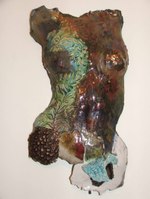 Lilith (below right), a gift from the kiln imps to hook me in and keep me forever interested in trying to figure out how to get what I want.
Lilith (below right), a gift from the kiln imps to hook me in and keep me forever interested in trying to figure out how to get what I want.
The last torso I did with raku buddy, Dhyana, named Isis (below left and also firing further down), was okay, but I have never gotten one as good as Lilith. Even with (and maybe especially with) the commercial glazes I have since tried seeking to get more consistancy. Lilith’s glazes were all home/hand-mixed.
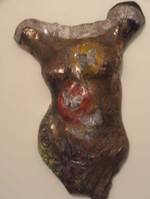 The raku process works like this: make piece. Fire it once low fire. That means that it is fired to non-vitrification – it is water permeable and cannot be left outside. The reason you do not fire to cone (to vitrification) is that firing to cone will solidify everything. Below cone, even though it feels hard, everything isn’t really solid and the clay platelets have room to move around in the fast heat/cool of the next steps. This could lead off into an exploration of what "solid" is and isn’t and how since everything is made up of moving atoms, nothing is really solid. But I won’t get sidetracked.
The raku process works like this: make piece. Fire it once low fire. That means that it is fired to non-vitrification – it is water permeable and cannot be left outside. The reason you do not fire to cone (to vitrification) is that firing to cone will solidify everything. Below cone, even though it feels hard, everything isn’t really solid and the clay platelets have room to move around in the fast heat/cool of the next steps. This could lead off into an exploration of what "solid" is and isn’t and how since everything is made up of moving atoms, nothing is really solid. But I won’t get sidetracked.
After that firing you take the piece, along with a bunch of others (it works best to spend several hours at a time, with a buddy, firing), and move to your raku kiln,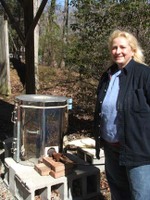 which in my case is on the back edge of my lot next to open space and the forest that is my adjacent lot, under a very high car port attached to a shed. You put the piece into the kiln (sometimes a project in itself since I keep forgetting this kiln is smaller than my regular one and the torsos are always right on the line of fitting or not, so I have to work at angling them), light the fire, get the roar (and I do mean roar) of the propane going, close the lid, and wait. What you are watching for in the peepholes is the glaze looking like "sun on ice." It goes through several phases, including bubbles. You can pull the piece out anytime depending on what you’re after finished wise. I’m usually after glaze/metallic lustre, so watch for the "sun" phenomenon. When the glaze is right, everything is red hot, including the piece. Make sure your visor is in place, long gloves are on and tongs are working. Now open the kiln, grab red red red hot hot hot piece with tongs (long tongs, heavy piece put in kiln at angle), pull it out and place it in a pit filled with, in my case, oak leaves and long pine needles (thank you yard). It catches fire. Put metal covering overtop, seal edges with dirt, wait. Lot’s of smoke.
which in my case is on the back edge of my lot next to open space and the forest that is my adjacent lot, under a very high car port attached to a shed. You put the piece into the kiln (sometimes a project in itself since I keep forgetting this kiln is smaller than my regular one and the torsos are always right on the line of fitting or not, so I have to work at angling them), light the fire, get the roar (and I do mean roar) of the propane going, close the lid, and wait. What you are watching for in the peepholes is the glaze looking like "sun on ice." It goes through several phases, including bubbles. You can pull the piece out anytime depending on what you’re after finished wise. I’m usually after glaze/metallic lustre, so watch for the "sun" phenomenon. When the glaze is right, everything is red hot, including the piece. Make sure your visor is in place, long gloves are on and tongs are working. Now open the kiln, grab red red red hot hot hot piece with tongs (long tongs, heavy piece put in kiln at angle), pull it out and place it in a pit filled with, in my case, oak leaves and long pine needles (thank you yard). It catches fire. Put metal covering overtop, seal edges with dirt, wait. Lot’s of smoke.
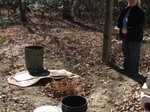
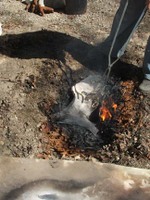 Smaller pieces can go in a trashcan. When they come out they go into water. Or you can let it cool in the pit (ha! that is a very long process and I am not a very patient person). Or you can pull it out and let it cool in the air. Variables in the finish include: temperature when you pull it out (not measured in my case, visual only), length of time from the second you open the kiln til you get the piece into the combustibles, how fast you get the top on the piece once the fire is started, how well you do or don’t seal the top over the fire, when you pull it out, how it cools. Oh yeah, and whether or not the piece makes it through all this without breaking into many pieces. I have had firings where that is all I got: pieces.
Smaller pieces can go in a trashcan. When they come out they go into water. Or you can let it cool in the pit (ha! that is a very long process and I am not a very patient person). Or you can pull it out and let it cool in the air. Variables in the finish include: temperature when you pull it out (not measured in my case, visual only), length of time from the second you open the kiln til you get the piece into the combustibles, how fast you get the top on the piece once the fire is started, how well you do or don’t seal the top over the fire, when you pull it out, how it cools. Oh yeah, and whether or not the piece makes it through all this without breaking into many pieces. I have had firings where that is all I got: pieces.
So that is raku – and I just ordered some horse hair to try yet another technique of finishing and am on the hunt for ferric chloride. The possibilities are endless. Clay is like life in that: the possibilities are endless. Output depends on input. Of all the clay processes, raku is the most like that. I love it!
Linda update: see myspace blog.
Thought for the day: "I would like to begin by talking about messengers. Messengers always exist in a triangular situation – the one who sends the message, the message-bearer, whether human or inorganic, and the one who receives the message. Picture, therefore, a triangle, but not a complete triangle: something more like an upside-down "V." The writer and the reader are at the two lateral corners, but there’s no line joining them. Between them – whether above or below, is a third point, which is the written word, or the text, or the book, or the poem, or the letter, or whatever you would like to call it. This third point is the only point of contact between the two. As I used to say to my wrting students in the distant days when I had some, ‘Respect the page. It’s all you’ve got.’
"The writer communicates with the page. The reader also communicates with the page. The writer and the reader communicate only through the page. This is one of the syllogisms of writing as such. Pay no attention to the facsimiles of the writer that appear on talkshows, in newspaper interviews, and the like – they ought not to have anything to do with what goes on between you, the reader, and the page you are reading, where an invisible hand has previously left some marks for you to deciper….
"The questions I would like to pose are, first: for whom does the writer write? And, secondly: what is the book’s function – or duty, if you like, in its position between writer and reader? What ought it to be doing, in the opinion of its writer? And finally, a third question arising from the other two: where is the writer when the reader is reading?
If you really are in the habit of reading other people’s letters and diaries, you’ll know the answer to that one straightaway: when you are reading, the writer is not in the same room. If he were, either you’d be talking together, or he’d catch you in the act." Margaret Atwood, Negotiating with the Dead: A Writer on Writing.

